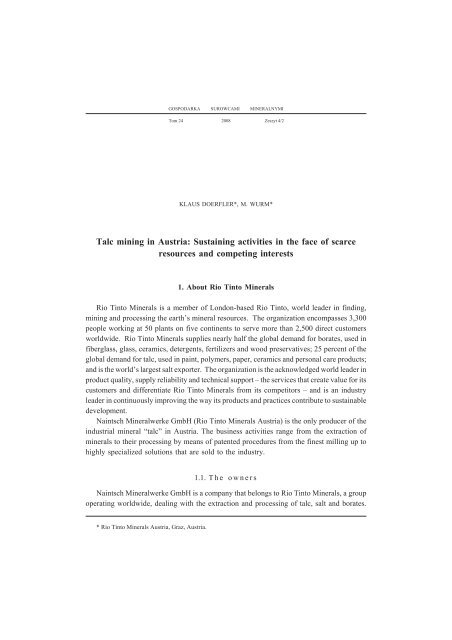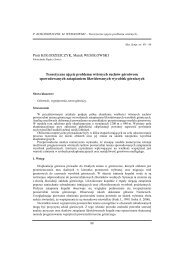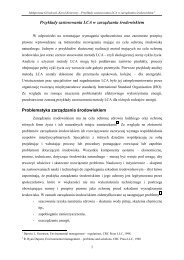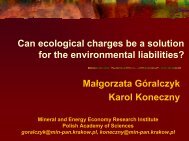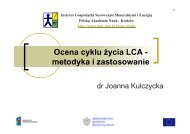Talc mining in Austria: Sustaining activities in the face of scarce ...
Talc mining in Austria: Sustaining activities in the face of scarce ...
Talc mining in Austria: Sustaining activities in the face of scarce ...
Create successful ePaper yourself
Turn your PDF publications into a flip-book with our unique Google optimized e-Paper software.
GOSPODARKA SUROWCAMI MINERALNYMI<br />
Tom 24 2008 Zeszyt 4/2<br />
KLAUS DOERFLER*, M. WURM*<br />
<strong>Talc</strong> <strong>m<strong>in</strong><strong>in</strong>g</strong> <strong>in</strong> <strong>Austria</strong>: Susta<strong>in</strong><strong>in</strong>g <strong>activities</strong> <strong>in</strong> <strong>the</strong> <strong>face</strong> <strong>of</strong> <strong>scarce</strong><br />
resources and compet<strong>in</strong>g <strong>in</strong>terests<br />
1. About Rio T<strong>in</strong>to M<strong>in</strong>erals<br />
Rio T<strong>in</strong>to M<strong>in</strong>erals is a member <strong>of</strong> London-based Rio T<strong>in</strong>to, world leader <strong>in</strong> f<strong>in</strong>d<strong>in</strong>g,<br />
<strong>m<strong>in</strong><strong>in</strong>g</strong> and process<strong>in</strong>g <strong>the</strong> earth’s m<strong>in</strong>eral resources. The organization encompasses 3,300<br />
people work<strong>in</strong>g at 50 plants on five cont<strong>in</strong>ents to serve more than 2,500 direct customers<br />
worldwide. Rio T<strong>in</strong>to M<strong>in</strong>erals supplies nearly half <strong>the</strong> global demand for borates, used <strong>in</strong><br />
fiberglass, glass, ceramics, detergents, fertilizers and wood preservatives; 25 percent <strong>of</strong> <strong>the</strong><br />
global demand for talc, used <strong>in</strong> pa<strong>in</strong>t, polymers, paper, ceramics and personal care products;<br />
and is <strong>the</strong> world’s largest salt exporter. The organization is <strong>the</strong> acknowledged world leader <strong>in</strong><br />
product quality, supply reliability and technical support – <strong>the</strong> services that create value for its<br />
customers and differentiate Rio T<strong>in</strong>to M<strong>in</strong>erals from its competitors – and is an <strong>in</strong>dustry<br />
leader <strong>in</strong> cont<strong>in</strong>uously improv<strong>in</strong>g <strong>the</strong> way its products and practices contribute to susta<strong>in</strong>able<br />
development.<br />
Na<strong>in</strong>tsch M<strong>in</strong>eralwerke GmbH (Rio T<strong>in</strong>to M<strong>in</strong>erals <strong>Austria</strong>) is <strong>the</strong> only producer <strong>of</strong> <strong>the</strong><br />
<strong>in</strong>dustrial m<strong>in</strong>eral “talc” <strong>in</strong> <strong>Austria</strong>. The bus<strong>in</strong>ess <strong>activities</strong> range from <strong>the</strong> extraction <strong>of</strong><br />
m<strong>in</strong>erals to <strong>the</strong>ir process<strong>in</strong>g by means <strong>of</strong> patented procedures from <strong>the</strong> f<strong>in</strong>est mill<strong>in</strong>g up to<br />
highly specialized solutions that are sold to <strong>the</strong> <strong>in</strong>dustry.<br />
1.1. T h e o w n e r s<br />
Na<strong>in</strong>tsch M<strong>in</strong>eralwerke GmbH is a company that belongs to Rio T<strong>in</strong>to M<strong>in</strong>erals, a group<br />
operat<strong>in</strong>g worldwide, deal<strong>in</strong>g with <strong>the</strong> extraction and process<strong>in</strong>g <strong>of</strong> talc, salt and borates.<br />
* Rio T<strong>in</strong>to M<strong>in</strong>erals <strong>Austria</strong>, Graz, <strong>Austria</strong>.
58<br />
They are based <strong>in</strong> Graz/Andritz <strong>in</strong> <strong>Austria</strong>. Na<strong>in</strong>tsch operates five sites <strong>in</strong> <strong>Austria</strong>. The crude<br />
m<strong>in</strong>eral is extracted <strong>in</strong> two talc m<strong>in</strong>es (Rabenwald near Weiz and Kle<strong>in</strong>feistritz near<br />
Judenburg). Both sites pursue susta<strong>in</strong>able safeguard<strong>in</strong>g <strong>of</strong> <strong>the</strong> raw material by means <strong>of</strong><br />
modern simulation models. In <strong>the</strong> plants <strong>in</strong> Oberfeistritz and Weißkirchen <strong>the</strong> crude m<strong>in</strong>eral<br />
is processed to high quality products for <strong>the</strong> <strong>in</strong>dustry by means <strong>of</strong> patented procedures.<br />
1.2. The operat<strong>in</strong>g figures<br />
In 2007 Na<strong>in</strong>tsch produced and sold about 180,000 tons <strong>of</strong> talc and products similar to<br />
talc. Na<strong>in</strong>tsch employs about 150 people <strong>in</strong> five Styrian locations and achieved a turnover <strong>of</strong><br />
about 55 million Euros <strong>in</strong> 2007. 85% <strong>of</strong> <strong>the</strong> production is exported all over <strong>the</strong> world. Here,<br />
<strong>the</strong> East European market is becom<strong>in</strong>g more and more important.<br />
The raw material: <strong>Talc</strong> („steatite“) is <strong>the</strong> s<strong>of</strong>test m<strong>in</strong>eral <strong>in</strong> <strong>the</strong> world. Its outstand<strong>in</strong>g<br />
features are <strong>the</strong> s<strong>of</strong>tness, <strong>the</strong> platelet shaped structure and <strong>the</strong> water repellent property.<br />
Typical scope <strong>of</strong> application: Did you know that an automobile conta<strong>in</strong>s up to 12 kg <strong>of</strong><br />
talc? Not only <strong>the</strong> plastic parts (dashboard, bumpers, carpet<strong>in</strong>g, airbag, tyres etc.) conta<strong>in</strong><br />
talc. The addition <strong>of</strong> talc allows <strong>the</strong> fitt<strong>in</strong>g <strong>of</strong> plastic components <strong>in</strong> <strong>the</strong> eng<strong>in</strong>e compartment.<br />
Apart from <strong>the</strong> resistance to heat talc allows <strong>the</strong> manufacture <strong>of</strong> lighter components, <strong>the</strong> total<br />
weight <strong>of</strong> <strong>the</strong> vehicle is reduced lead<strong>in</strong>g to <strong>the</strong> reduction <strong>of</strong> <strong>the</strong> petrol consumption. In <strong>the</strong><br />
long run, <strong>the</strong> plastic parts filled with talc can be recycled <strong>in</strong> an easier way at <strong>the</strong> end <strong>of</strong> <strong>the</strong> life<br />
cycle.<br />
Health and safety: The health and safety <strong>of</strong> all employees as well as contractors are <strong>of</strong><br />
vital importance to Na<strong>in</strong>tsch. In 2003 and <strong>in</strong> 2005 Na<strong>in</strong>tsch was nom<strong>in</strong>ated for <strong>the</strong> <strong>Austria</strong>n<br />
state award and consequently achieved a recommendation as „Best Practise“ <strong>in</strong> <strong>the</strong> context <strong>of</strong><br />
<strong>the</strong> European Safety Award 2005.<br />
Susta<strong>in</strong>able development: Raw materials are <strong>the</strong> basis for <strong>the</strong> pleasant th<strong>in</strong>gs <strong>of</strong> daily<br />
needs and <strong>in</strong>crease our standard <strong>of</strong> liv<strong>in</strong>g. The extraction <strong>of</strong> raw material always has an<br />
impact on <strong>the</strong> environment. To keep this impact as low as possible and to consider <strong>the</strong><br />
concerns <strong>of</strong> <strong>the</strong> owners, employees, communities and customers <strong>in</strong> equal measure, RTM<br />
strives for a susta<strong>in</strong>able development <strong>of</strong> <strong>the</strong> company. A balance between <strong>the</strong> economic<br />
success, <strong>the</strong> social well-be<strong>in</strong>g and <strong>the</strong> protection <strong>of</strong> <strong>the</strong> environment is to show <strong>the</strong> way to<br />
assure a long term future.<br />
1.3. T h e s i t e s<br />
Graz: The head <strong>of</strong>fice <strong>in</strong> Graz-Andritz deals with sales, <strong>the</strong> central adm<strong>in</strong>istration and is<br />
<strong>the</strong> headquarters <strong>of</strong> <strong>the</strong> bus<strong>in</strong>ess management.<br />
Rabenwald: The biggest talc deposit <strong>of</strong> Central Europe can be found <strong>in</strong> <strong>the</strong> region <strong>of</strong><br />
Rabenwald near Weiz (Eastern Styria). About 100,000 tons <strong>of</strong> talc are extracted a year at <strong>the</strong><br />
open pit <strong>in</strong> Rabenwald: Rabenwald employs about 35 people <strong>in</strong> <strong>the</strong> production and <strong>the</strong><br />
adm<strong>in</strong>istration. After complet<strong>in</strong>g <strong>the</strong> extract<strong>in</strong>g operations, <strong>the</strong> excavated terraces are com-
pletely recultivated. To this date, about 190,000 trees have been afforested serv<strong>in</strong>g at <strong>the</strong><br />
same time as a natural visual protection for <strong>the</strong> environment. To keep <strong>the</strong> environmental<br />
impact for <strong>the</strong> region as low as possible, most <strong>of</strong> <strong>the</strong> rock is transported to <strong>the</strong> nearby plant <strong>in</strong><br />
Oberfeistritz.<br />
Oberfeistritz: Na<strong>in</strong>tsch operates a process<strong>in</strong>g plant for talc <strong>in</strong> Oberfeistritz. There, <strong>the</strong><br />
rock is reduced to small pieces, sorted automatically and afterwards milled <strong>in</strong> various<br />
f<strong>in</strong>enesses. This way, <strong>the</strong> plant with its 40 employees yearly produces about 100,000 tons <strong>of</strong><br />
preciously processed raw materials for <strong>the</strong> <strong>in</strong>dustry.<br />
Kle<strong>in</strong>feistritz: One <strong>of</strong> <strong>the</strong> m<strong>in</strong>es <strong>of</strong> Na<strong>in</strong>tsch is located near Kle<strong>in</strong>feistritz (Upper Styria<br />
near Judenburg). There, about 20,000 tons <strong>of</strong> a m<strong>in</strong>eral similar to talc are extracted yearly<br />
(Leukophyllit). This m<strong>in</strong>e employ<strong>in</strong>g 5 people is <strong>the</strong> smallest one <strong>of</strong> Rio T<strong>in</strong>to worldwide and<br />
meets <strong>the</strong> highest <strong>in</strong>ternational safety and environmental standards. The material is transported<br />
to Weißkirchen for fur<strong>the</strong>r process<strong>in</strong>g.<br />
Weißkirchen: Na<strong>in</strong>tsch operates ano<strong>the</strong>r process<strong>in</strong>g plant at <strong>the</strong> site <strong>in</strong> Weißkirchen. Apart<br />
from <strong>the</strong> raw material from <strong>the</strong> m<strong>in</strong>e <strong>in</strong> Kle<strong>in</strong>feistritz, <strong>the</strong> plant also processes raw materials<br />
from o<strong>the</strong>r <strong>Austria</strong>n and <strong>in</strong>ternational deposits. By means <strong>of</strong> most modern mill<strong>in</strong>g plants,<br />
80,000 tons <strong>of</strong> raw materials are produced yearly for <strong>the</strong> <strong>in</strong>dustry. The plant employs 45 people.<br />
59<br />
2. Regional policies<br />
The <strong>Austria</strong>n M<strong>in</strong><strong>in</strong>g <strong>in</strong>dustry is challenged by <strong>the</strong> competition <strong>of</strong> <strong>in</strong>terests <strong>of</strong> diverse<br />
stakeholders. While <strong>the</strong> exploitation <strong>of</strong> m<strong>in</strong>eral resources is still acknowledged a public<br />
<strong>in</strong>terest <strong>the</strong> use <strong>of</strong> property as build<strong>in</strong>g land and grow<strong>in</strong>g tourism are limit<strong>in</strong>g <strong>the</strong> extension <strong>of</strong><br />
operations. M<strong>in</strong><strong>in</strong>g <strong>activities</strong> have to care for long term concepts clearly outl<strong>in</strong>ed and<br />
<strong>in</strong>tegrated <strong>in</strong>to <strong>the</strong> regional policies.<br />
This requires a good knowledge about <strong>the</strong> potential dimensions <strong>of</strong> relevant deposits and<br />
a long term orientation <strong>of</strong> bus<strong>in</strong>ess far <strong>in</strong> advance to well def<strong>in</strong>ed <strong>m<strong>in</strong><strong>in</strong>g</strong> projects.<br />
In case <strong>of</strong> <strong>the</strong> deposits m<strong>in</strong>ed by RTM <strong>Austria</strong> <strong>the</strong> global structure <strong>of</strong> <strong>the</strong> ore bodies are<br />
well known and promise an extension <strong>of</strong> operations lifetime for many decades. It is <strong>the</strong> policy<br />
<strong>of</strong> <strong>the</strong> company to observe carefully all areas <strong>of</strong> future <strong>in</strong>terests and claim for be<strong>in</strong>g<br />
acknowledged <strong>in</strong> <strong>the</strong> regional policies.<br />
3. Orebody Knowledge and Long Term M<strong>in</strong>e Plann<strong>in</strong>g<br />
A resource model is a computer based representation <strong>of</strong> a deposit <strong>in</strong> which geological<br />
zones are def<strong>in</strong>ed and filled with blocks which are assigned estimated values <strong>of</strong> grades and<br />
o<strong>the</strong>r attributes. Each m<strong>in</strong>eral deposit presents unique geologic characters, <strong>the</strong>refore modell<strong>in</strong>g<br />
techniques and parameters must be determ<strong>in</strong>ed carefully to design <strong>the</strong> most appropriate<br />
geologic model and fur<strong>the</strong>rmore a m<strong>in</strong>eral resource estimate.
60<br />
A certa<strong>in</strong> process has to be followed to establish a reliable m<strong>in</strong>eral reserves estimate.<br />
The Resource Database builds <strong>the</strong> basis necessary for <strong>the</strong> estimation and is established by<br />
<strong>the</strong> collection, validation and process<strong>in</strong>g <strong>of</strong> data. A QA/QC program is preferred to adm<strong>in</strong>istrate<br />
<strong>the</strong> collection <strong>of</strong> all data. From <strong>the</strong> beg<strong>in</strong>n<strong>in</strong>g concurrent collection <strong>of</strong> prelim<strong>in</strong>ary<br />
economic, <strong>m<strong>in</strong><strong>in</strong>g</strong>, metallurgical, environmental, legal and social data and o<strong>the</strong>r <strong>in</strong>formation<br />
is required.<br />
The Geological Interpretation targets <strong>the</strong> def<strong>in</strong>ition <strong>of</strong> geological controls for <strong>the</strong> m<strong>in</strong>eralization<br />
and focuses especially on <strong>the</strong> understand<strong>in</strong>g <strong>of</strong> <strong>the</strong> relationship between <strong>the</strong><br />
m<strong>in</strong>eralization and <strong>the</strong> related geological processes that govern its emplacement and geometry<br />
with<strong>in</strong> <strong>the</strong> geological framework. With<strong>in</strong> this context, construction <strong>of</strong> lithology<br />
doma<strong>in</strong>s, economic m<strong>in</strong>eralisation doma<strong>in</strong>s, geotechnical doma<strong>in</strong>s, and <strong>the</strong> <strong>in</strong>tegration <strong>of</strong><br />
structural and m<strong>in</strong>e operat<strong>in</strong>g data are considered. F<strong>in</strong>ally, <strong>the</strong> <strong>in</strong>terpretation requires validation<br />
before progression to <strong>the</strong> grade/ quality estimation stage.<br />
The conceptual Geological Model and ideas regard<strong>in</strong>g <strong>the</strong> genesis <strong>of</strong> <strong>the</strong> deposit allows<br />
construct<strong>in</strong>g a block model where each geological doma<strong>in</strong> gets filled with blocks <strong>of</strong> a unique<br />
code. These doma<strong>in</strong>s also prevent <strong>the</strong> unrealistic smoo<strong>the</strong>n<strong>in</strong>g and spread<strong>in</strong>g <strong>of</strong> estimated<br />
block grades across different lithological zones.<br />
Reliable M<strong>in</strong>eral Resource Estimates require geostatistical and estimation practices to<br />
estimate <strong>the</strong> required grade and o<strong>the</strong>r relevant variables <strong>in</strong>to a suitable block or mesh model.<br />
Variables potentially constra<strong>in</strong><strong>in</strong>g process and <strong>m<strong>in</strong><strong>in</strong>g</strong> should be also <strong>in</strong>cluded. Increas<strong>in</strong>g<br />
sophistication <strong>of</strong> s<strong>of</strong>tware packages and improved hardware speeds mean that it is now quite<br />
easy to perform multiple estimates us<strong>in</strong>g different methods <strong>in</strong> order to compare <strong>the</strong> results.<br />
For example, non-geostatistical methods, such as nearest neighbour can be compared<br />
with geostatistical methods such as krig<strong>in</strong>g. The choice <strong>of</strong> <strong>the</strong> appropriate method depends on<br />
circumstances, and need not always <strong>in</strong>volve geostatistics, but <strong>the</strong> analytical work beforehand<br />
should give a good idea <strong>of</strong> which method or methods are likely to be most successful. The<br />
selection <strong>of</strong> <strong>the</strong> method should be geared to what is required <strong>of</strong> <strong>the</strong> result and to <strong>the</strong><br />
characteristics identified dur<strong>in</strong>g <strong>the</strong> preced<strong>in</strong>g modell<strong>in</strong>g steps.<br />
Accord<strong>in</strong>g to CIM 2003 <strong>the</strong>re are a number <strong>of</strong> quantify<strong>in</strong>g elements or Modify<strong>in</strong>g Factors<br />
that should be considered <strong>in</strong> <strong>the</strong> conversion <strong>of</strong> a M<strong>in</strong>eral Resource to a M<strong>in</strong>eral Reserve.<br />
Industrial m<strong>in</strong>erals with<strong>in</strong> Rio T<strong>in</strong>to are covered by <strong>the</strong> JORC Code and <strong>the</strong>refore <strong>the</strong> ma<strong>in</strong><br />
elements/factors to be considered <strong>in</strong>clude <strong>m<strong>in</strong><strong>in</strong>g</strong>, metallurgy, geotechnical, hydrological,<br />
environmental, location, market<strong>in</strong>g, legal requirements, revenue, costs and social implications.<br />
A key criterion for M<strong>in</strong>eral Reserve Estimate is <strong>the</strong> determ<strong>in</strong>ation <strong>of</strong> economic viability.<br />
An important aspect <strong>of</strong> this is <strong>the</strong> practicality <strong>of</strong> <strong>the</strong> <strong>m<strong>in</strong><strong>in</strong>g</strong> and process<strong>in</strong>g methods proposed<br />
for <strong>the</strong> deposit. Optimisation <strong>of</strong> <strong>m<strong>in</strong><strong>in</strong>g</strong> limits and sequenc<strong>in</strong>g follows <strong>the</strong> def<strong>in</strong>ition <strong>of</strong> <strong>the</strong><br />
<strong>m<strong>in</strong><strong>in</strong>g</strong> method and <strong>in</strong>itial m<strong>in</strong>e design. The optimisation is a high level analysis <strong>of</strong> a strategic<br />
nature, tak<strong>in</strong>g <strong>in</strong>to account all <strong>of</strong> <strong>the</strong> value cha<strong>in</strong> (from resources <strong>in</strong> <strong>the</strong> ground through to <strong>the</strong><br />
customers), to estimate relative NPV for a range <strong>of</strong> physical, economic and regulatory<br />
scenarios. The basic strategy <strong>of</strong> how <strong>the</strong> m<strong>in</strong>e is to be developed and sequenced needs to be
determ<strong>in</strong>ed and <strong>in</strong>corporated <strong>in</strong>to <strong>the</strong> Development Strategy. This <strong>of</strong>ten determ<strong>in</strong>es <strong>the</strong><br />
tim<strong>in</strong>g <strong>of</strong> key <strong>in</strong>stallations as well as milestones such as first ore production. This may have<br />
a significant direct impact on NPV and various strategies may be used like <strong>in</strong>puts to <strong>the</strong><br />
optimisation process.<br />
The ultimate check <strong>of</strong> a m<strong>in</strong>eral reserve estimate is through appropriate production<br />
monitor<strong>in</strong>g and Reconciliation. The Model to M<strong>in</strong>e Reconciliation focuses on <strong>the</strong> comparison<br />
<strong>of</strong> identical volumes <strong>of</strong> material, one as predicted from <strong>the</strong> resource model and <strong>the</strong><br />
o<strong>the</strong>r one from <strong>the</strong> m<strong>in</strong>e production reports. In an operat<strong>in</strong>g m<strong>in</strong>e, reconciliation <strong>of</strong> m<strong>in</strong>e to<br />
mill production and m<strong>in</strong>e production to reserve estimates should be conducted on a rout<strong>in</strong>e<br />
basis. The results <strong>of</strong> <strong>the</strong> reconciliation must be considered <strong>in</strong> <strong>the</strong> report<strong>in</strong>g <strong>of</strong> M<strong>in</strong>eral<br />
Reserves.<br />
61<br />
4. Excellence <strong>in</strong> Drill<strong>in</strong>g & Blast<strong>in</strong>g<br />
4.1. Head<strong>in</strong>g for excellence<br />
Rio T<strong>in</strong>to M<strong>in</strong>erals has launched an Operational Excellence program (OpEx) <strong>in</strong> order to<br />
improve competitiveness. OpEx provides a platform for <strong>the</strong> achievement <strong>of</strong> goals by improv<strong>in</strong>g<br />
<strong>the</strong> speed and quality <strong>of</strong> improvement <strong>in</strong>itiatives. Operational Excellence is about<br />
systematically improv<strong>in</strong>g <strong>the</strong> performance <strong>of</strong> operations by reduc<strong>in</strong>g variability and push<strong>in</strong>g<br />
processes closer to <strong>the</strong>ir maximum economic capability.<br />
4.2. Generat<strong>in</strong>g Excellence Standards<br />
In a first run key performance drivers (KPDs) are identified and used for <strong>the</strong> evaluation <strong>of</strong><br />
<strong>the</strong> process capability. Performance gaps towards common targets and standards achievements<br />
get evident.<br />
For start<strong>in</strong>g <strong>the</strong> loop improvement process bottom up <strong>the</strong> KPDs are first cascaded down to<br />
<strong>the</strong> workforce and <strong>the</strong> workplaces. The workforce is encouraged to track <strong>the</strong>ir performance <strong>in</strong><br />
visual workplace platforms and generate improvement ideas. Progress means measures<br />
aga<strong>in</strong>st past performance.<br />
For <strong>in</strong>duc<strong>in</strong>g step changes new technology and toolkit are implemented <strong>in</strong> partnership<br />
with experts. Communities <strong>of</strong> practice are consulted for easy exchange <strong>of</strong> state <strong>of</strong> <strong>the</strong> art<br />
technology with<strong>in</strong> <strong>the</strong> company.<br />
4.3. Excellence Standards <strong>in</strong> Drill<strong>in</strong>g & Blast<strong>in</strong>g on Rabenwald<br />
Open pit m<strong>in</strong>e<br />
Drill<strong>in</strong>g & blast<strong>in</strong>g is an important process step which is commonly applied <strong>in</strong> various<br />
operations.
62<br />
Photo. 1. Blast Metrix Rabenwald<br />
Fot. 1. Blast Metrix Rabenwald<br />
On Rabenwald some 2 million tonnes <strong>of</strong> waste rock has to be removed; a significant part<br />
has to be drilled and blasted <strong>in</strong> advance.<br />
The process has been mapped <strong>in</strong> detail from plann<strong>in</strong>g to documentation and fragmented<br />
<strong>in</strong>to functional chunks. After review and alignment to an optimized work flow <strong>the</strong> tasks have<br />
been documented <strong>in</strong> standard work procedures and fed back to <strong>the</strong> workforce. Major steps<br />
forward could be achieved by implement<strong>in</strong>g more precise plann<strong>in</strong>g tools us<strong>in</strong>g state <strong>of</strong> <strong>the</strong> art<br />
techniques (BlastMetrics) and an improvement <strong>of</strong> <strong>the</strong> accuracy <strong>of</strong> drill<strong>in</strong>g. Detailed documentation<br />
<strong>of</strong> blast<strong>in</strong>g results and track<strong>in</strong>g results on visual workplace boards ensure <strong>the</strong><br />
learn<strong>in</strong>g progress proceed<strong>in</strong>g well.<br />
5. Project: Plastorit M<strong>in</strong>e Kle<strong>in</strong>feistritz<br />
5.1. M<strong>in</strong>e on <strong>the</strong> move<br />
RTM <strong>Austria</strong> operates a small underground m<strong>in</strong>e located near <strong>the</strong> town <strong>of</strong> Zeltweg<br />
approximately 100 km northwest <strong>of</strong> <strong>the</strong> regional city <strong>of</strong> Graz <strong>in</strong> sou<strong>the</strong>ast <strong>Austria</strong>.<br />
The m<strong>in</strong>e produces roughly 20,000 tonnes <strong>of</strong> leukophyllite (white schist) to be processed<br />
at <strong>the</strong> Weißkirchen Plant produc<strong>in</strong>g PLASTORIT, i.e. brand name for mica-chlorite-quartz<br />
products as a high value additive for <strong>the</strong> pa<strong>in</strong>t and plaster market.<br />
After an extraction period <strong>of</strong> 90 years <strong>the</strong> <strong>m<strong>in</strong><strong>in</strong>g</strong> <strong>activities</strong> had to be moved due to<br />
exhaustion <strong>of</strong> reserves <strong>in</strong> one area <strong>of</strong> <strong>the</strong> deposit. Core drill<strong>in</strong>gs <strong>in</strong> <strong>the</strong> eastern cont<strong>in</strong>uation <strong>of</strong><br />
<strong>the</strong> geological structure have been taken as a basis for def<strong>in</strong><strong>in</strong>g a model <strong>of</strong> deposit and for<br />
prov<strong>in</strong>g huge reserves with consistent quality <strong>of</strong> material for many decades. M<strong>in</strong>e plann<strong>in</strong>g<br />
has been guided by geotechnical studies <strong>in</strong> cooperation with <strong>the</strong> M<strong>in</strong><strong>in</strong>g department at <strong>the</strong><br />
University <strong>of</strong> Leoben. Studies resulted <strong>in</strong> a sur<strong>face</strong> <strong>in</strong>frastructure and underground <strong>m<strong>in</strong><strong>in</strong>g</strong><br />
concept which has been well accepted by all stakeholders <strong>in</strong>volved.
63<br />
Fig. 1. New and Old M<strong>in</strong>e Kle<strong>in</strong>feistritz<br />
Rys. 1. Nowa i stara kopalnia Kle<strong>in</strong>feistritz<br />
Photo. 2. M<strong>in</strong>e Kle<strong>in</strong>feistritz<br />
Fot. 2. Kopalnia Kle<strong>in</strong>feistritz<br />
5.2. Social and environmental aspects<br />
The operation is situated <strong>in</strong> a sensible area which is outl<strong>in</strong>ed as a landscape conservation<br />
area. Extensive bio diversity impact studies were started early enough <strong>in</strong> order to align<br />
operational plann<strong>in</strong>g to environmental requirements from <strong>the</strong> very beg<strong>in</strong>n<strong>in</strong>g. As a result<br />
a satisfy<strong>in</strong>g consensus could be settled at an early stage <strong>of</strong> <strong>the</strong> project. Key factors have been<br />
<strong>the</strong> cont<strong>in</strong>uation <strong>of</strong> underground <strong>m<strong>in</strong><strong>in</strong>g</strong> technique and <strong>the</strong> implementation <strong>of</strong> a modern back<br />
fill<strong>in</strong>g system provid<strong>in</strong>g m<strong>in</strong>imum impact on <strong>the</strong> sur<strong>face</strong> affected by <strong>m<strong>in</strong><strong>in</strong>g</strong> <strong>activities</strong>. This<br />
<strong>m<strong>in</strong><strong>in</strong>g</strong> method assures a maximum recovery and contributes to <strong>the</strong> susta<strong>in</strong>ability targets <strong>of</strong><br />
<strong>the</strong> operation. These efforts have been well appreciated by <strong>the</strong> local community which has<br />
been <strong>in</strong>formed about all steps <strong>of</strong> <strong>the</strong> project right <strong>in</strong> time.<br />
This strategy has also been applied for all clean up <strong>activities</strong>. Land owners have been<br />
<strong>in</strong>volved <strong>in</strong>to <strong>the</strong> detailed plann<strong>in</strong>g based on <strong>the</strong> long term exist<strong>in</strong>g closure plan. Their<br />
<strong>in</strong>terests will be considered to an extensive grade. The comprehensive plan for <strong>the</strong> abundant<br />
works tackles <strong>the</strong> removal <strong>of</strong> sur<strong>face</strong> and underground <strong>in</strong>stallations and <strong>the</strong> backfill<strong>in</strong>g <strong>of</strong><br />
near to sur<strong>face</strong> open<strong>in</strong>gs. Long term water dra<strong>in</strong>age will be provided, <strong>the</strong> sur<strong>face</strong> area has to<br />
be rehabilitated, kept fenced and controlled via a long term monitor<strong>in</strong>g program. Infrastructure<br />
which can be used for forestry (timber<strong>in</strong>g) like roads will be bargemen to land<br />
owners.<br />
5.3. Economical Success<br />
F<strong>in</strong>ally this project will provide a major economical success to <strong>the</strong> company. By implement<strong>in</strong>g<br />
new techniques and dimensions <strong>the</strong> productivity nearly doubles. It fits also well<br />
<strong>in</strong>to <strong>the</strong> emerg<strong>in</strong>g demand for Plastorit on <strong>the</strong> market places.
64<br />
6. Project: South Pit Rabenwald<br />
6.1. G o i n g S o u t h<br />
RTM <strong>Austria</strong> operates an open pit talc m<strong>in</strong>e at Rabenwald located approximately 40 km<br />
nor<strong>the</strong>ast <strong>of</strong> <strong>the</strong> regional city <strong>of</strong> Graz <strong>in</strong> sou<strong>the</strong>ast <strong>Austria</strong>.<br />
The open pit m<strong>in</strong>e produces roughly 100,000 tonnes <strong>of</strong> talc to be processed at <strong>the</strong><br />
Oberfeistritz Plant produc<strong>in</strong>g MISTRON, i.e. brand name for talc products used <strong>in</strong> pitch<br />
control for paper mills and o<strong>the</strong>r products for ceramics, pa<strong>in</strong>t <strong>in</strong>dustries and ro<strong>of</strong><strong>in</strong>g.<br />
For a long time period <strong>of</strong> decades extraction was concentrated at <strong>the</strong> nor<strong>the</strong>rn end <strong>of</strong> <strong>the</strong><br />
deposit (“North pit”). In order to cont<strong>in</strong>ue its bus<strong>in</strong>ess <strong>the</strong> operation proposed to open a new<br />
m<strong>in</strong>e <strong>in</strong> <strong>the</strong> sou<strong>the</strong>rn cont<strong>in</strong>uation <strong>of</strong> <strong>the</strong> ore body <strong>in</strong> <strong>the</strong> area <strong>of</strong> <strong>the</strong> former Krugh<strong>of</strong> Pit<br />
(“South pit”). An extensive exploration program has proven significant reserves and quality<br />
parameters well <strong>in</strong> l<strong>in</strong>e with <strong>the</strong> demand from <strong>the</strong> market. In a first step approximately<br />
3 million tonnes <strong>of</strong> waste have to be removed. This will provide access to reserves cover<strong>in</strong>g<br />
<strong>the</strong> demand for roughly <strong>the</strong> next 2 decades. A geotechnical study prov<strong>in</strong>g slope stabilities has<br />
been done <strong>in</strong> cooperation with <strong>the</strong> Institute for Rock Mechanics at <strong>the</strong> University <strong>of</strong> Graz.<br />
M<strong>in</strong>e plann<strong>in</strong>g was done <strong>in</strong> house us<strong>in</strong>g modern tools provid<strong>in</strong>g a maximum value under <strong>the</strong><br />
restrictions <strong>of</strong> social and environmental aspects.<br />
Photo. 3. Open Pit Rabenwald<br />
Fot. 3. Odkrywka Rabenwald
65<br />
6.2. Social and environmental aspects<br />
As <strong>the</strong> extraction area is situated on top <strong>of</strong> <strong>the</strong> mounta<strong>in</strong> ridge visibility <strong>of</strong> operation is<br />
a major aspect to be considered <strong>in</strong> advance. In <strong>the</strong> new South pit <strong>the</strong> same pr<strong>in</strong>ciple will be<br />
applied like <strong>in</strong> North Pit operation: Dump areas that have been completed will be rehabilitated<br />
as soon as possible and protect <strong>the</strong> pit area aga<strong>in</strong>st visibility. Waste extracted will be<br />
dumped <strong>in</strong>side <strong>the</strong> exhausted pit wall to keep <strong>the</strong> open pit area as small as possible. This<br />
aligns also with <strong>the</strong> target <strong>of</strong> m<strong>in</strong>imiz<strong>in</strong>g dust and noise emissions. A biodiversity base study<br />
has been applied and potential impacts considered carefully. F<strong>in</strong>ally great attention was<br />
given to <strong>the</strong> water management concept as <strong>the</strong> area is an important supplier for <strong>the</strong> communities.<br />
Local communities and representatives from <strong>the</strong> nearby Pöllauer Naturpark have been<br />
<strong>in</strong>formed and <strong>in</strong>volved <strong>in</strong> <strong>the</strong> plann<strong>in</strong>g process at a very early stage <strong>in</strong> order to achieve fully<br />
acceptance by all stakeholders. As RTM <strong>Austria</strong> is a major employer <strong>in</strong> that region and well<br />
known as a company work<strong>in</strong>g <strong>in</strong> an environmentally responsible manner <strong>the</strong> long term<br />
project has been appreciated by <strong>the</strong> stakeholders.<br />
6.3. Economical Success<br />
A long term cont<strong>in</strong>uation <strong>of</strong> talc extraction <strong>in</strong> <strong>the</strong> heart <strong>of</strong> Europe is a key for an<br />
economical success <strong>of</strong> <strong>the</strong> company. Excellence <strong>in</strong> all processes and short logistic distances<br />
to customers ensure a susta<strong>in</strong>able value.<br />
7. Dump<strong>in</strong>g <strong>of</strong> waste rock<br />
The talc deposit on Rabenwald open pit m<strong>in</strong>e is extracted from <strong>the</strong> north southbound.<br />
The cont<strong>in</strong>uation <strong>of</strong> <strong>the</strong> <strong>m<strong>in</strong><strong>in</strong>g</strong> <strong>activities</strong> doesn’t cause a significant horizontal <strong>m<strong>in</strong><strong>in</strong>g</strong><br />
expansion, yet a vertical one. In do<strong>in</strong>g so, a m<strong>in</strong>imization <strong>of</strong> <strong>the</strong> impact on <strong>the</strong> environment is<br />
strived for. The plann<strong>in</strong>g criteria that are relevant to <strong>the</strong> environment are <strong>the</strong> follow<strong>in</strong>g:<br />
— Visual, dust and noise protection for <strong>the</strong> neighbourhood, <strong>in</strong> particular with regard to<br />
<strong>the</strong> tourist resorts <strong>in</strong> <strong>the</strong> valleys. This protection is guaranteed by <strong>the</strong> m<strong>in</strong>e management<br />
us<strong>in</strong>g natural and artificial (waste rock) scenes. Particularly <strong>the</strong> visual protection<br />
is realised by means <strong>of</strong> efficient rehabilitation <strong>of</strong> completed waste rock dumps.<br />
— M<strong>in</strong>imization <strong>of</strong> <strong>the</strong> sur<strong>face</strong> demands for extraction and waste rock dumps (m<strong>in</strong>imization<br />
<strong>of</strong> <strong>the</strong> open sur<strong>face</strong>). The m<strong>in</strong>imization <strong>of</strong> <strong>the</strong> sur<strong>face</strong> demand could be<br />
realised by apply<strong>in</strong>g <strong>the</strong> back <strong>in</strong> pit dump<strong>in</strong>g concept and by prompt rehabilitation and<br />
reforestation <strong>of</strong> each area where extraction has been completed.<br />
— Measures to guarantee <strong>the</strong> utilisation <strong>of</strong> <strong>the</strong> sur<strong>face</strong> after complet<strong>in</strong>g <strong>the</strong> extraction or<br />
<strong>m<strong>in</strong><strong>in</strong>g</strong> <strong>activities</strong>. Rehabilitation is already considered when plann<strong>in</strong>g <strong>the</strong> waste rock<br />
dumps and <strong>the</strong> f<strong>in</strong>al state <strong>of</strong> <strong>the</strong> open pit area. Representatives <strong>of</strong> regional authorities<br />
determ<strong>in</strong>e <strong>in</strong> accordance with representatives <strong>of</strong> <strong>in</strong>terested parties for future uti-
66<br />
lisation which sur<strong>face</strong>s are to be used <strong>in</strong> which way after <strong>the</strong> completion <strong>of</strong> <strong>the</strong> <strong>m<strong>in</strong><strong>in</strong>g</strong><br />
<strong>activities</strong>.<br />
— Measures to protect abutt<strong>in</strong>g owners and waters: A detailed water dra<strong>in</strong>age plan has<br />
been established for <strong>the</strong> m<strong>in</strong>e on Rabenwald toge<strong>the</strong>r with <strong>the</strong> open pit plant management<br />
by means <strong>of</strong> natural and artificial scenes, thus guarantee<strong>in</strong>g that, <strong>in</strong> accordance<br />
with <strong>the</strong> extraction plan, <strong>the</strong> dra<strong>in</strong>age areas <strong>of</strong> <strong>the</strong> four concerned receiv<strong>in</strong>g<br />
waters, <strong>the</strong>ir deposition as well as <strong>the</strong> dra<strong>in</strong>age proportions are only slightly changed<br />
and restored unchanged by means <strong>of</strong> rehabilitation <strong>of</strong> <strong>the</strong> f<strong>in</strong>al pit area after completion<br />
<strong>of</strong> extraction.<br />
Dur<strong>in</strong>g <strong>the</strong> extraction all precipitation waters from <strong>the</strong> open pit are circulated to <strong>the</strong><br />
clarifier and flood detention bas<strong>in</strong> via <strong>the</strong> adequately dimensioned dra<strong>in</strong>age ditches as well as<br />
<strong>the</strong> accumulative and <strong>in</strong>flow channels to such an extent that harmful water emissions can not<br />
occur.<br />
7.1. Rehabilitation<br />
The company is aware <strong>of</strong> <strong>the</strong> fact that <strong>the</strong> open pit <strong>m<strong>in</strong><strong>in</strong>g</strong> <strong>in</strong>terferes with nature and<br />
<strong>the</strong>refore, <strong>the</strong>ir prior target has to be <strong>the</strong> immediate rehabilitation <strong>of</strong> areas where extraction<br />
has been completed. Dur<strong>in</strong>g <strong>the</strong> rehabilitation one has to differentiate between a temporary<br />
rehabilitation and a f<strong>in</strong>al one with reforestation.<br />
Dur<strong>in</strong>g <strong>the</strong> rehabilitation <strong>the</strong> temporary completed m<strong>in</strong>e sur<strong>face</strong> is vegetated and replanted<br />
thus protect<strong>in</strong>g <strong>the</strong> sur<strong>face</strong> aga<strong>in</strong>st erosion.<br />
In do<strong>in</strong>g so, new soil is spread onto <strong>the</strong> sur<strong>face</strong>, occasionally rehabilitated by means <strong>of</strong><br />
plant<strong>in</strong>g vegetation without humus us<strong>in</strong>g a hydraulic spray<strong>in</strong>g method or re-natured with<br />
a newly denuded humus. In case <strong>of</strong> a temporary rehabilitation <strong>of</strong> small areas, <strong>the</strong> plant<strong>in</strong>g<br />
vegetation is carried out <strong>the</strong> usual way by hand.<br />
Areas f<strong>in</strong>ally extracted are rehabilitated immediately, i.e. new soil or humus is spread on<br />
top, <strong>the</strong>y are vegetated and after successful plant<strong>in</strong>g vegetation <strong>the</strong>y are forested with<br />
a typical biodiversity <strong>of</strong> wood species depend<strong>in</strong>g on <strong>the</strong> altitude. In case <strong>of</strong> an exposed m<strong>in</strong>e<br />
area at an altitude <strong>of</strong> about 1,100 m <strong>the</strong>se areas are rehabilitated or re-natured as forest area<br />
with ecological niche structures, irrespective <strong>of</strong> <strong>the</strong> fact if <strong>the</strong> orig<strong>in</strong>al cropland was a forest,<br />
farmland or waste land.<br />
A large research project called „m<strong>in</strong>e habitat“ was carried out for <strong>the</strong> plann<strong>in</strong>g and<br />
evaluation <strong>of</strong> <strong>the</strong> ecological value <strong>in</strong> terms <strong>of</strong> rehabilitation operations. This <strong>in</strong>cludes<br />
a survey <strong>of</strong> about 26 habitat types as well as an evaluation <strong>of</strong> <strong>the</strong> measures taken so far for<br />
rehabilitation.<br />
A specious and locally typical mixed forest that is <strong>in</strong> accordance with <strong>the</strong> habitat has been<br />
foreseen to reuse <strong>the</strong> m<strong>in</strong>e area after completion <strong>of</strong> <strong>the</strong> <strong>m<strong>in</strong><strong>in</strong>g</strong> <strong>activities</strong>, with regard to <strong>the</strong><br />
altitude <strong>of</strong> <strong>the</strong> m<strong>in</strong>e as well as <strong>the</strong> chang<strong>in</strong>g climate factors.<br />
The long term target is to avoid a fur<strong>the</strong>r expansion <strong>of</strong> <strong>the</strong> area be<strong>in</strong>g claimed by <strong>the</strong> open<br />
pit operations and to restore <strong>the</strong> orig<strong>in</strong>al character <strong>of</strong> <strong>the</strong> landscape <strong>in</strong> a technically and
economically possible extent dur<strong>in</strong>g <strong>the</strong> safeguard<strong>in</strong>g <strong>of</strong> <strong>the</strong> sur<strong>face</strong> utilisation after completion<br />
<strong>of</strong> <strong>the</strong> <strong>m<strong>in</strong><strong>in</strong>g</strong> <strong>activities</strong>.<br />
67<br />
Conclusion<br />
Long term <strong>m<strong>in</strong><strong>in</strong>g</strong> concepts have to be stated and embedded <strong>in</strong> regional policies at an<br />
early stage. The ore body knowledge is a key from <strong>the</strong> beg<strong>in</strong>n<strong>in</strong>g and allows optimized<br />
plann<strong>in</strong>g <strong>of</strong> all fur<strong>the</strong>r <strong>activities</strong>. M<strong>in</strong>e cycle plann<strong>in</strong>g has to follow a susta<strong>in</strong>able approach<br />
and <strong>in</strong>volves extraction, dump<strong>in</strong>g, rehabilitation and closure <strong>activities</strong>. Social and economical<br />
aspects have to be treated as well as economical ones. Head<strong>in</strong>g for Operational<br />
Excellence assures competitiveness and state <strong>of</strong> <strong>the</strong> art appliance for all major <strong>activities</strong>. The<br />
<strong>in</strong>volvement <strong>of</strong> communities at each step provides broad trust to <strong>the</strong> company and allows<br />
extension projects well accepted by neighbours and o<strong>the</strong>r local stakeholders.<br />
REFERENCES<br />
[1] CIM, 2003 – Estimation <strong>of</strong> m<strong>in</strong>eral resources and m<strong>in</strong>eral reserves. Best practice guidel<strong>in</strong>es.<br />
[2] D u k e J.H., H a n n a P.J., 1997 – Geological <strong>in</strong>terpretation for resource estimation. Proceed<strong>in</strong>g <strong>of</strong> <strong>the</strong> resource<br />
database towards 2000 ,Wollongong, Australia: AusIMM Sem<strong>in</strong>ar.<br />
[3] JORC, 2004 – Australasian Code for Report<strong>in</strong>g <strong>of</strong> Exploration Results. M<strong>in</strong>eral Resources and Ore Reserves<br />
(The JORC-Code 2004). – The Jo<strong>in</strong>t Ore Reserves Committee <strong>of</strong> <strong>the</strong> Australasian Institute <strong>of</strong> M<strong>in</strong><strong>in</strong>g and<br />
Metallurgy, Australian Institute <strong>of</strong> Geoscientists and M<strong>in</strong>erals Council <strong>of</strong> Australia (JORC), 1–20.<br />
[4] Rio T<strong>in</strong>to IPT Standards V14 for OK&SMP (<strong>in</strong>ternal document).<br />
GÓRNICTWO TALKU W AUSTRII: DZIA£ANIA ZRÓWNOWA¯ONE W OBLICZU NIEWYSTARCZAJ¥CYCH Z£Ó¯<br />
I INTERESÓW KONKURUJ¥CYCH<br />
S³owa kluczowe<br />
Zarz¹dzanie biznesem, standardy ochrony œrodowiska, m<strong>in</strong>era³y przemys³owe, wiedza o z³o¿ach rud, rozwój<br />
zrównowa¿ony [red.]<br />
Streszczenie<br />
Rio T<strong>in</strong>to M<strong>in</strong>erals to globalny najwiêkszy dostawca produktów talku, które stosowane s¹ w przemyœle<br />
farbiarskim, polimerowym i papierniczym. Firma zale¿na w Austrii u¿ytkuje dwie kopalnie w oparciu o d³ugotrwa³e<br />
rezerwy z³ó¿. Dzia³ania górnicze musz¹ zawieraæ wyraŸnie nakreœlone d³ugotrwa³e koncepcje, z<strong>in</strong>tegrowane<br />
z zasadami polityki regionalnej. Dla zapewnienia rozwoju projektów nale¿y wczeœniej uwa¿nie analizowaæ<br />
aspekty spo³eczne i œrodowiskowe, aby zagwarantowaæ zrównowa¿ony charakter dzia³alnoœci.<br />
D¹¿enie do doskona³oœci: Pocz¹wszy od dok³adnego modelu z³o¿a, planowanie kopalni jest skoncentrowane<br />
na zapewnieniu maksimum wartoœci dla wszystkich akcjonariuszy z uwzglêdnieniem aspektów spo³ecznych<br />
i ochrony œrodowiska. Znaczne wysi³ki w³o¿ono w planowanie ha³d i rekultywacjê istniej¹cej kopalni odkrywkowej,<br />
dla m<strong>in</strong>imalizacji zajmowanej powierzchni i zapewnienia widocznoœci wszystkich dzia³añ górniczych.
68<br />
Dziêki przestrzeganiu tych zasad, Rio T<strong>in</strong>to M<strong>in</strong>erals pomyœlnie rozw<strong>in</strong>ê³o istniej¹c¹ kopalniê odkrywkow¹<br />
o kolejn¹ odkrywkê i otworzy³o nowe dzia³ania pod ziemi¹.<br />
TALC MINING IN AUSTRIA: SUSTAINING ACTIVITIES IN THE FACE OF SCARCE RESOURCES AND COMPETING<br />
INTERESTS<br />
Key words<br />
Bus<strong>in</strong>ess management, environmental standards, <strong>in</strong>dustrial m<strong>in</strong>eral, orebody knowledge, susta<strong>in</strong>able development<br />
[red.]<br />
Abstract<br />
Rio T<strong>in</strong>to M<strong>in</strong>erals is <strong>the</strong> global number one supplier for talc products, which are found <strong>in</strong> <strong>the</strong> pa<strong>in</strong>t, polymer<br />
and paper <strong>in</strong>dustries. The subsidiary <strong>in</strong> <strong>Austria</strong> operates two m<strong>in</strong>es both based on deposits bear<strong>in</strong>g long term<br />
reserves. M<strong>in</strong><strong>in</strong>g <strong>activities</strong> have to care for long term concepts clearly outl<strong>in</strong>ed and <strong>in</strong>tegrated <strong>in</strong>to <strong>the</strong> regional<br />
policies. For extension projects social and environmental aspects have to be studied carefully <strong>in</strong> advance to<br />
guarantee <strong>the</strong> susta<strong>in</strong>ability <strong>of</strong> operations.<br />
Head<strong>in</strong>g for excellence: Start<strong>in</strong>g with a precise model <strong>of</strong> <strong>the</strong> deposit m<strong>in</strong>e plann<strong>in</strong>g is focused on provid<strong>in</strong>g<br />
maximum value for all stakeholders <strong>in</strong>clud<strong>in</strong>g environmental and social aspects. Great efforts are made <strong>in</strong> plann<strong>in</strong>g<br />
dumps and rehabilitation <strong>in</strong> <strong>the</strong> exist<strong>in</strong>g open pit m<strong>in</strong>e m<strong>in</strong>imiz<strong>in</strong>g <strong>the</strong> footpr<strong>in</strong>t and visibility <strong>of</strong> all <strong>m<strong>in</strong><strong>in</strong>g</strong><br />
<strong>activities</strong>.<br />
By respect<strong>in</strong>g <strong>the</strong>se pr<strong>in</strong>ciples Rio T<strong>in</strong>to M<strong>in</strong>erals has successfully expanded an exist<strong>in</strong>g open pit m<strong>in</strong>e for<br />
ano<strong>the</strong>r pit and opened up a new underground operation.


